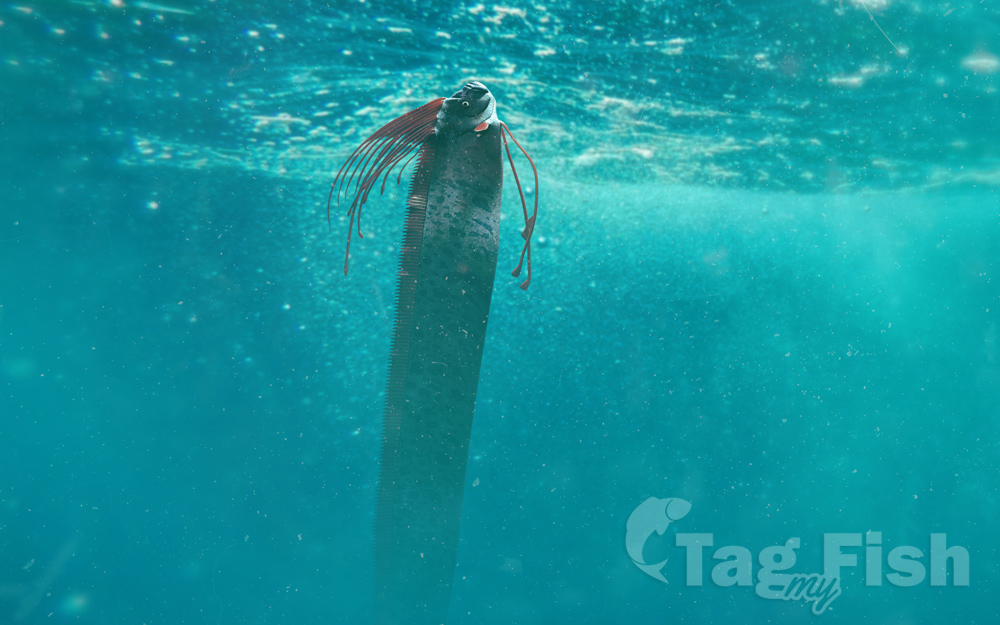Giant oarfish
(Regalecus glesne)

Classification
General data
The giant oarfish (Regalecus glesne) is a species of oarfish of the family Regalecidae. It is an oceanodromous species with a worldwide distribution, excluding polar regions. Other common names include Pacific oarfish, king of herrings, ribbonfish, and streamer fish.
R. glesne is the world’s longest bony fish. Its shape is ribbon-like, narrow laterally, with a dorsal fin along its entire length, stubby pectoral fins, and long, oar-shaped pelvic fins, from which its common name is derived. Its coloration is silvery with dark markings, and its fins are red. Its physical characteristics and its undulating mode of swimming have led to speculation that it might be the source of many ’sea serpent’ sightings.
Distribution
The giant oarfish is found worldwide in the upper layers of the open ocean (the pelagic zone). It is believed to be oceanodromous, following its primary food source. It has been found as far north as 72°N and as far south as 52°S, but is most common in the tropics to middle latitudes. It is thought to inhabit the sunlit epipelagic to dimly lit mesopelagic zones, ranging as deeply as 1,000 m (3,300 ft) below the surface.
Description
This species is the world’s longest bony fish, reaching a record length of 8 m (26 ft); however, unconfirmed specimens of up to 11 m (36 ft) have been reported. It is commonly measured to 3 m (9.8 ft) in total length. The maximum recorded weight of a giant oarfish is 270 kg (600 lb).
Its shape is ribbonlike, narrow laterally, with a dorsal fin along its entire length from between its eyes to the tip of its tail. The fin rays are soft and may number up to 400 or more. At the head of the fish, the rays are lengthened forming a distinctive red crest. Its pectoral and pelvic fins are nearly adjacent. The pectoral fins are stubby while the pelvic fins are long, single-rayed, and reminiscent of an oar in shape, widening at the tip. Its head is small with the protrusible jaw typical of lampriformes; it has 40 to 58 gill rakers, and no teeth.
The organs of the giant oarfish are concentrated toward the head end of the body, possibly enabling it to survive losing large portions of its tail. It has no swim bladder. The liver of R. glesne is orange or red, the likely result of astaxanthin in its diet. The lateral line begins above and behind the eye then, descending to the lower third of the body, extends to the caudal tip.
The skin of R. glesne is scaleless but covered with tubercles. The skin color is silver with streaks, spots or splotches of black or dark gray, and a bluish or brownish tinge on the head. Its fins, including its long dorsal fin and crest, are red, again probably resulting from its diet.
Behavior
Little is known about oarfish behavior. It has been observed swimming by means of its dorsal fin, and also swimming in a vertical position. In 2010, scientists filmed a giant oarfish in the Gulf of Mexico swimming in the mesopelagic layer, the first footage of a reliably identified R. glesne in its natural setting. The footage was caught during a survey, using an ROV in the vicinity of Thunder Horse PDQ, and shows the fish swimming in a columnar orientation, tail downward.
It feeds on krill and other small crustaceans, as well as small fish and squid. It is known to spawn from July to December. The eggs are 2.5 mm (0.1 in) large, and float near the surface until hatching. Its larvae are also observed near the surface during this season.[8] As an adult, it is believed to be solitary.











